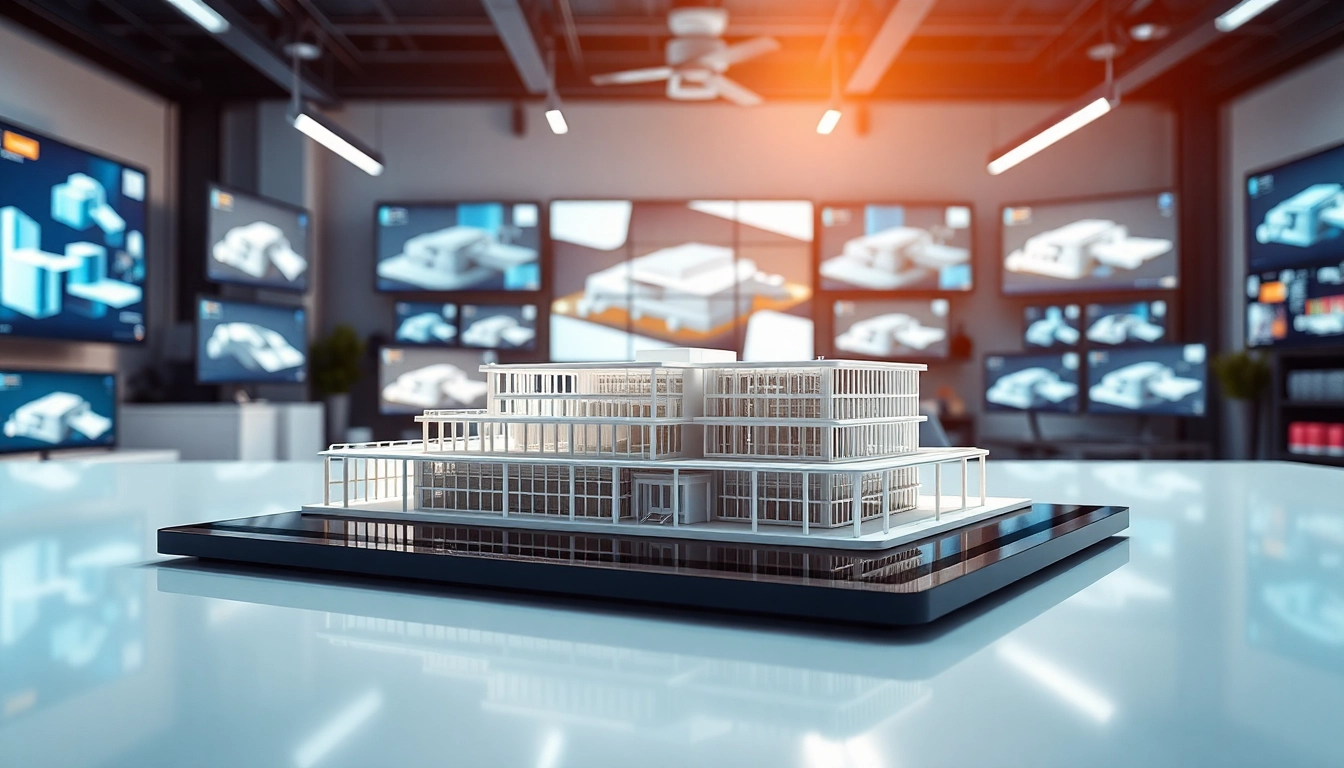Enhancing Design Efforts Through Effective 3D Model Visualizations
Understanding 3D Model Visualizations
What are 3D Model Visualizations?
3D model visualizations are digital representations of objects or environments created using three-dimensional software. These visualizations enable designers and artists to present their ideas in a visually engaging and accurate manner, allowing for a comprehensive understanding of spatial relationships, design intricacies, and dimensional characteristics. By utilizing 3D model visualizations, creators can build more immersive experiences that resonate well with their target audience, enhancing the overall impact of their presentations and designs.
The Importance of 3D Visualizations in Modern Design
In contemporary design, the importance of 3D visualizations cannot be overstated. They serve as a transformative tool across numerous fields, including architecture, engineering, product design, and marketing. Key advantages include:
- Enhanced Comprehension: Complex designs become easier to understand when viewed in three dimensions, which helps stakeholders visualize projects before they’re built or manufactured.
- Improved Communication: 3D visualizations facilitate better communication among team members and clients, as they provide a clear visual reference that can bridge gaps in understanding.
- Time and Cost Savings: By identifying potential issues in a design phase through 3D visualization, teams can mitigate costly revisions post-production, thereby streamlining workflows and saving time.
Common Applications of 3D Model Visualizations
3D model visualizations find applications in a multitude of industries, each leveraging the technology to meet specific needs:
- Architecture: Architects utilize 3D visualizations to create realistic representations of buildings and give stakeholders an immersive view of completed projects before construction begins.
- Product Design: 3D visualization allows designers to refine their concepts, integrating functional and aesthetic considerations while assessing usability and ergonomics.
- Healthcare: In medicine, 3D models are used for surgical planning and training, giving medical professionals access to highly detailed representations of anatomy.
- Marketing: Advertisers create 3D visualizations of products that appeal to consumers emotionally, showcasing functionality and design in an attractive format.
Tools and Software for 3D Model Visualizations
Overview of Popular 3D Visualization Software
A wide variety of software tools are available for creating 3D model visualizations, each catering to different levels of expertise and specific project requirements:
- Autodesk Maya: Known for its powerful modeling capabilities, Maya is favored in the professional animation industry and often used in creating high-quality character models and environments.
- Blender: This free and open-source software offers robust features, including modeling, rigging, animation, and rendering, making it a popular choice among indie developers and freelancers.
- SketchUp: Renowned for its user-friendly interface, SketchUp is widely used for architectural design and interior design, allowing users to create detailed 3D models with minimal learning curve.
- 3ds Max: Another popular Autodesk product, 3ds Max is particularly well-suited for creating 3D animations and visualizations for the media and entertainment industry.
- Unity: Primarily a game engine, Unity also offers tools for designers to create interactive 3D visualizations suited for augmented reality (AR) and virtual reality (VR) environments.
Comparison of Free vs. Paid 3D Visualization Tools
Choosing between free and paid 3D visualization tools often depends on specific project needs, budget constraints, and the desired level of technical sophistication. Free tools like Blender provide extensive functionalities without the financial burden, making them appealing for individuals or startups. However, they may require more time investment to master compared to paid software that often comes with comprehensive customer support and easier usability.
Here’s a brief comparison:
| Feature | Free Tools | Paid Tools |
|---|---|---|
| Cost | Free | Varies; typically requires a subscription or one-time purchase |
| User Community | Strong open-source community support | Direct customer support from the company |
| Learning Curve | Generally steeper for advanced features | Usually easier, with tutorials and documentation available |
| Features | Comprehensive but may lack some high-end functionalities | Robust and tailored for professional use |
Integrating 3D Visualization Software into Your Workflow
To effectively integrate 3D visualization software into your workflow, consider the following steps:
- Identify Your Needs: Determine which features and functionalities are crucial for your projects. This helps in selecting the right software.
- Train Your Team: Provide training for your team to ensure they are proficient in using the chosen software, as this will aid in achieving high-quality visualizations.
- Set Clear Goals: Establish specific objectives for your projects, such as achieving a certain level of detail or a particular visualization style.
- Continuously Seek Feedback: Collect feedback from stakeholders and team members during the visualization process to ensure alignment with the project goals.
- Iterate and Improve: Use insights gained from feedback to refine your techniques and processes for future projects.
Best Practices for Creating Stunning 3D Model Visualizations
Design Principles to Consider
Creating visually appealing 3D model visualizations demands an understanding of fundamental design principles:
- Balance: Ensuring that all visual elements have a well-distributed presence within the composition creates harmony and aesthetically pleasing results.
- Contrast: Utilizing contrasting colors, shapes, and textures can help highlight important features of the model, guiding the viewer’s attention.
- Hierarchy: Establishing a clear visual hierarchy allows viewers to comprehend the essential elements of the 3D model and leads them through the design.
- Texture and Detail: High-resolution textures and intricate details enhance realism, making the visualization more compelling.
Utilizing Textures and Lighting Effectively
Textures and lighting are vital components in achieving believable and captivating 3D visualizations. Key considerations include:
- Texture Maps: Applying texture maps can create surface variations and depth, giving the model a more authentic appearance. Consider using PBR (Physically Based Rendering) materials to simulate how objects interact with light.
- Lighting Techniques: Utilize different lighting setups (e.g., direct, ambient, spot) to influence the mood and atmosphere. Experiment with shadows to create a sense of depth.
- Environment Interaction: Incorporate environmental elements such as reflections and shadows cast by surrounding objects to enhance realism.
Common Mistakes to Avoid in 3D Visualizations
Awareness of potential pitfalls is crucial for creating effective 3D visualizations:
- Overcluttered Scenes: A common mistake is overcrowding a scene with too many elements, which can distract from the primary subject. Opt for a minimalistic approach to keep the focus clear.
- Poor Texturing: Neglecting detail in textures can lead to unrealistic models. Attention to material properties, such as glossiness and bump mapping, significantly enhances visual appeal.
- Ignoring User Feedback: Failing to incorporate feedback from users can result in designs that miss the mark. Always engage with stakeholders to align on expectations and project goals.
Case Studies: Successful Implementations of 3D Model Visualizations
Industry-Specific Examples
Real-world examples showcase how various industries have successfully utilized 3D model visualizations to achieve strategic goals:
- Automotive Industry: Major car manufacturers like Ford and BMW employ 3D visualizations to design vehicles and showcase them in virtual environments, allowing for better analysis and consumer engagement.
- Real Estate: Companies like Zillow leverage 3D visualizations to create virtual tours of properties, increasing user engagement and providing clients with a sense of the spaces before visiting.
- Telecommunications: Companies like Apple use 3D visualizations for designing hardware components and marketing, allowing impressive product showcases at events.
Lessons Learned from Leading Brands
Big brands have shared valuable insights from their experiences:
- Innovation: Stay at the forefront of technology by adopting emerging software and techniques, just as Tesla does with its unique design processes.
- Engagement: Successful brands often invest in customer engagement by soliciting feedback on 3D visualizations, facilitating user-centric design improvements.
- Sustainability: Integrating sustainability into design thinking has become essential. Brands focusing on eco-friendly visualizations attract conscious consumers who value these efforts.
How to Measure Success in 3D Visualizations
Evaluating the effectiveness of 3D model visualizations involves several metrics:
- User Engagement: Analyze user interaction with visual content through metrics like time spent on page and click-through rates. Higher engagement often reflects effective visualization.
- Conversion Rates: For marketing purposes, monitor how 3D visualizations influence purchasing decisions. This can include tracking product preorders or inquiries generated from visual content.
- Client Feedback: Engage with clients and stakeholders continuously to assess their perceptions of the visualizations, gathering qualitative data that can guide future improvements.
The Future of 3D Model Visualizations
Emerging Trends in 3D Technology
The realm of 3D model visualizations is rapidly evolving, with trends shaping the future:
- Real-Time Rendering: Advancements in real-time rendering technologies allow designers to make adjustments on the fly, significantly reducing production time and improving interactivity.
- Augmented Reality (AR) and Virtual Reality (VR): Integrating AR and VR into visualization enhances user experiences, providing immersive environments that foster engagement with products or designs.
- Cloud-Based Collaboration: Cloud platforms are streamlining collaboration among remote teams, enabling simultaneous access to 3D models and enhancing productivity.
How AI is Shaping 3D Visualizations
Artificial intelligence is transforming the landscape of 3D visualizations in impactful ways:
- Automated Design Generation: AI algorithms can analyze design patterns and generate optimized 3D models, saving time for designers by providing preliminary drafts.
- Intelligent Texturing: AI can assist in applying textures by predicting and suggesting suitable options based on the model’s geometry and intended use, enhancing overall quality.
- Realistic Simulations: Machine learning techniques enable more realistic simulations of physics in 3D environments, enhancing interactivity and user experience.
Preparing for the Next Generation of 3D Modeling
To stay relevant in the ever-evolving 3D visualization landscape, professionals should:
- Continuously Learn: Keep abreast of technological advancements and software updates to leverage new features and functionalities.
- Engage with Communities: Participate in online forums and groups to connect with other professionals, share insights, and learn from experiences.
- Emphasize User-Centric Design: Focus on user needs and preferences in the design process, ensuring that visualizations resonate with target audiences.










